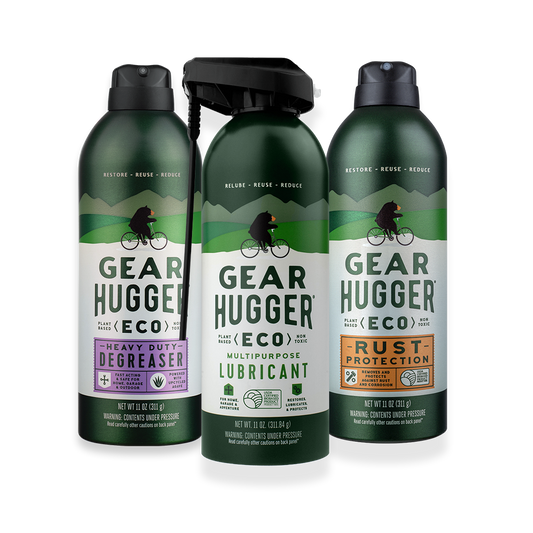Chances are you’ve heard of Teflon before or you've purchased an item that contains it. It’s a well-known coating used to make household items nonstick—most famously, cookware. It’s also used in clothing, personal care products, and manufacturing to create a waterproof surface.
Teflon is the brand name of a chemical coating called Polytetrafluoroethylene (PTFE)—try saying that three times fast. PTFE was discovered in the 1930’s by a chemist whose company he was working for eventually trademarked the name Teflon, which is what PTFE is most commonly known as.
Teflon, PTFEs and Safety
Unfortunately, there’s serious debate about the safety of PTFE for humans (and the planet!) because it’s been linked to a slew of serious health conditions. 😳 Not to mention, it’s a synthetic chemical that will not degrade for millions of years, unless it’s exposed to very high temperatures. And when Teflon is exposed to high heat it releases a very toxic chemical group known as perfluorinated compounds (PFCs) into the air.
Yet, Teflon is still FDA-approved and used in a number of everyday products. Let’s take a closer look at where you should keep an eye out for it, if it’s really as dangerous as we hear, and how to replace it with safer alternatives. Here are five concerns with Teflon:
- Before 2013 (only 10 years ago!) Teflon products contained PFOA, a chemical found to produce higher rates of kidney and testicular cancer, as well as ulcerative colitis, thyroid disease, and other conditions.
- Even today Teflon made without PFOA lasts for an incredibly long time, so it can pollute waterways and natural environments without any way for remediation.
- When teflon coatings are heated to high temperatures or scratched/damaged they can still release toxic fumes, potentially causing flu-like symptoms such as cough, chills, and fever. Many call this reaction the “Teflon Flu!”
- Teflon found in sunscreen, moisturizer, and other similar products can seep into the skin and remain in the body for long periods of time, leading to those health risks we just mentioned and more.
Teflon Use Today
Make sure to read product packaging as Teflon tends to sneak into many household items. Here’s where to keep an eye out for it:
- Cosmetics including skin and hair care products that claim to provide a smooth silky finish (from the use of Teflon or PTFEs)
- Waterproof jackets and other clothing that claim improved water beading
- Microwave popcorn uses Teflon to help prevent popcorn from sticking to the bag
- Many couches and other fabric-clad furniture use Teflon so liquid spills roll off instead of soaking in
- Cookware with a non-stick coating includes some waffle makers, rice cookers, baking pans, toaster oven trays, baking molds, electric griddles etc.
- Many hairstyling tools such as curlers and flat irons
- Even some dental floss brands
Teflon in Lubricants
Most spray lubricants also contain Teflon because of its claim to help repel dirt and moisture. However, spraying Teflon sends PTFE into the air where it’s breathed in by the user and surrounding people and falls onto the ground with the overspray. For example, if someone uses a spray chemical-based lubricant on their bike chain, a considerable amount of this synthetic product will end up on the ground, exposing plants, the soil, and animals while disrupting the natural environment.
Natural alternatives to Teflon
When it comes to household items, double check those labels, especially for cookware and skincare! This creates an easy entryway for PTFE into your body.
Cookware with a ceramic coating instead is a great alternative because it is non toxic and has some natural non-stick properties. Another great option for cookware is using stainless steel pots and pans and pairing them with your favorite cooking oil to create a non-stick surface.
And look for more plant-powered alternatives for skincare and beyond! For example, Gear Hugger makes a plant-based, non-toxic multi-purpose lubricant as a safe-for-you-and-the-planet solution that outperforms traditional chemical-based sprays with 3x the lubricating power. And the formula is biodegradable so people can enjoy biking, gardening, automotive building, and other tasks with a lower environmental impact and knowing they are not breathing in the synthetic chemicals.
Thankfully there are a growing number of simple swaps to create a more sustainable and non-toxic household today. Look for those callouts like “Teflon-free” or “PTFE-free” that are making them easier to spot due to the large demand of people actively avoiding Teflon!
Conclusion
Given the potential health risks associated with Teflon, it is important to consider alternative options that are safer for both our health and the environment. By swapping to natural and eco-friendly products, like Gear Hugger, we can reduce our exposure to harmful chemicals and minimize our impact on the environment for ourselves and future generations!





